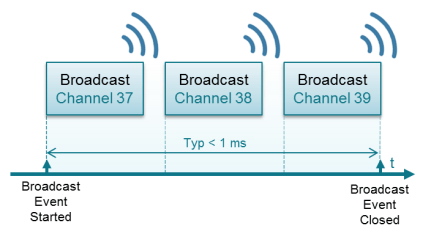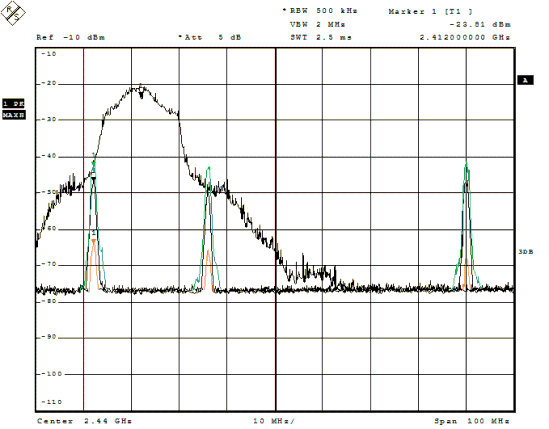SWRA475A January 2015 – October 2016 CC2540 , CC2540T , CC2541 , CC2541-Q1
2.8 Coexistence
The open 2.4 GHz ISM frequency band that is used by Bluetooth low energy is filled with many other wireless protocols, such as Wi-Fi, as well as potential interference from home appliances, such as microwave ovens. These radio activities may interfere with the Bluetooth low energy activity. The broadcasting of advertisements occurs on three different channels sequentially as demonstrated in Figure 6.
 Figure 6. Broadcasting Advertisements
Figure 6. Broadcasting Advertisements The channels 37, 38 and 39 have been chosen to not collide with the three most commonly used Wi-Fi channels; 1, 6 and 11, as shown in Figure 7.
 Figure 7. Frequency Band and Channels, Bluetooth low energy
Figure 7. Frequency Band and Channels, Bluetooth low energy However, Wi-Fi has significantly higher output power, up to 23 dBm compared to maximum allowed 10 dBm for Bluetooth low energy. This means that placing a beacon very close to a Wi-Fi source will probably distort the transmitted data as spurious emissions on side channels of the Wi-Fi unit will almost always occur on a non-ideal RF product, as show in Figure 8. Figure 8 shows the three broadcast output power peaks on advertising channels 37, 38 and 39 versus the Wi-Fi output peak for streaming data at 24 Mbit/s.
 Figure 8. Spectrum for Wi-Fi Channel 1 versus Beacon Advertisements Channels
Figure 8. Spectrum for Wi-Fi Channel 1 versus Beacon Advertisements Channels If Wi-Fi runs on other channels that overlap with the broadcasting channels, it is dependent on the received signal strength (RSSI) at the receiving device. Even though the advertising channels for Bluetooth low energy has been strategically placed in the 2.4 GHz ISM band to not interfere with the most common Wi-Fi channels, Figure 8 shows that interference and coexistence issues with these particular Wi-Fi channels could be present anyway. However, it should be noted that the frequency spectrum was measured with a beacon residing directly on top of a Wi-Fi device.
Depending on the Beacon application, there are different requirements on coexistence. Even a small amount of active beacons tend to interfere with each other and cause packets to be lost. As already seen, Wi-Fi has in general higher TX-power as well as wider occupancy in the 2.4 GHz ISM band than Bluetooth low energy devices.